[Added September 14th, 2012] After a bitter, unfair and unequal battle against her cancer, Yvonne Oerlemans died on Friday September 14th, 2012, in Amsterdam "... dat jij een tumor spéélt, in muziek & geluid, hè? want een tumor, dat is natuurlijk ook een vibratie, een resonantie..." Yvonne Oerlemans was born in 1945, in Breda. Listen to Yvonne, one more time.
Mythical beasts, corsets and kites
april 18, 2008.
Dutch artist Yvonne Oerlemans (1945-2012) signs a small and intimate oeuvre on which she has been working since the mid 1970s. I got to know Yvonne in Amsterdam in the late 1980s at a time that she was primarily working with video. Wijnand de Groot and I composed and recorded the music (for viola & piano) that is the soundtrack to Yvonne's De Appeleters (a seven minute narrative about power and parent-child relations, shot in the style of an early 'silent movie' in 1988). We also did the soundtrack (with violin, acoustic guitar & tapes) for the very short Brains, in 1990. At that time we were able to witness how each next one of Yvonne's pieces arose as the result of an often long and slow process of research, of trial and error. Her work has always been primarily about a personal growth towards liberation and - ultimately - freedom, a thematics that finds a particular clear expression in her series of (installations and performances involving) corsets and kites.
Below is a picture of Yvonne's Vogel (Bird), which may be seen as a hybrid of a corset and a kite: the bird ('kite') was made from a wooden bird's cage ('corset'). The cage is the bird and the bird is its cage ...
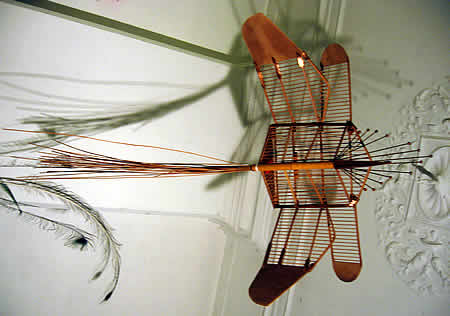
The bird is from 1987. Around the same time Yvonne made three other such, as she calls them, Mythical Beasts, all out of materials that, like the elegant wooden bird cage, she found and picked up from among the waste and rubbish in the streets of Amsterdam. Thus Yvonne made a Leeuwenhond, met verlichte kop, a 'Liondog, with enlightened head', which has a lampshade (inclusive a functioning light bulb) as its head. And one day, on the pavement near the entrance to Artis, the Amsterdam zoo, she picked up the conserved upper part of a large fish, a (northern) pike (which is called a snoek in dutch). The fish head became part of the Zeemeerman, met Zelfdragend Water ('Merman, with Self-supporting Water'). The most abstract, arguably, of this 'mythical quartet' is a pair of snails, with reflecting eyes; that is, two little round mirrors that will reflect the eye of a beholder, who thus in a way will become herself a 'part of the beast' ...
(You may click the pictures below to have a closer look.)
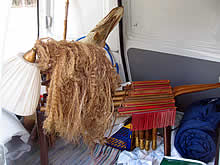 |
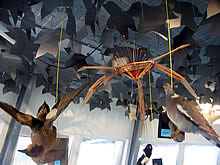 |
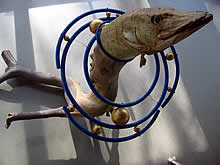 |
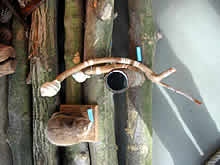 |
Until the end of the first week of may 2008 you can visit Yvonne's Mythical Beasts in the Visitor's Center of the Amsterdamse Bos. For all of the months of march and april Yvonne installed them there, on a raft made from tree trunks taken from the 'forest'. On the raft the Mythical Beasts are being kept company by a selection from the Visitor's Center's collection of stuffed animals, most of which once died (a natural death) in or near the Amsterdam Forest.
The result is sort of a Noach's Raft, heaven-bound ...
I composed a one hour soundtrack, endlessly repeating, as a sonic environment for this odd troupe to travel in. The track comes together with two thirty second cassette tape loops, of found sounds recorded onto found (telephone answering machine message-)tapes, which are looping in found cassette players, one placed below, and a second one above the raft. I called the track: Wolf, waar ben je? ("Where are you, Wolf?"), a title that refers to a french children's song & play ('Loup y es-tu?'); it also is meant as a warning for the traveling beasts who should stay alert, for it might just be that unbeknownst to all, there is a '_wolf_' among them ...; and finally it invites the listener to try and spot the sound of the wolf ... (Which, by the way, makes me wonder, does the sound of the wolf relate to its name?)
Like Yvonne's Mythical Beasts, and as a matter
of fact like all of the 'Amsterdam Forest', Wolf, waar ben
je? is of an artificial, of a re-cycled nature.
The piece was laid out as a series of disconnected patches of field recordings,
strung together along a grid consisting of a recording of one hundred and
forty ( * ) pizzicato tones (as played by the fine
little software toy Musik?)
that I also used for Raudio's
third ZandOog podcast. The basic grid consists in these 140 tones sounding
with entry points at 25 second intervals. (When arranged in a circle this
adds up to precisely one hour.) Over a copy of this grid I then distributed
a selection of nature-and-related field recordings from my archives, with
the characteristics duration, color and weather
of the sound fragments changing over time from on the average relatively
'short', 'light' and 'sunny' to 'long', 'dark' and 'grim'. I adapted the
entry points of the pizzicato tones in the grid to fit dynamic and melodic
accents, as well as the beginning and end of the fragments. Finally this
filled in and re-arranged grid is overlaid with a copy of the original series
of 140 Musik? pizzicato's
at 25 second distance ...
...
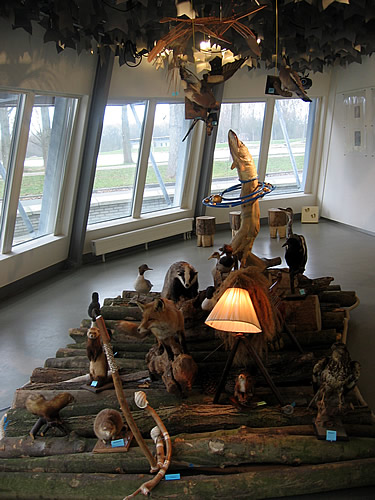
...
The Amsterdam Forest is a large
park, that was created from scratch on unused turf- and wetlands to the
south-west of the city. The idea to start 'cultivating' the area in order
to allow for a bit of nearby 'nature' for the Amsterdam citizens to dwell
in, goes back to around 1900, but it took until 1927 for the first serious plans to be
drawn up. The so called Boschplan ('forest plan') aimed at extending
the recreational facilities of the dutch capital, and actually became an
important means to provide work for the many unemployed during the economic
crisis in the 1930s when the works began, in 1934. Work on the 'Boschplan'
continued throughout the german occupation in the early 1940s, when prisoners
were put to work there. The municipality of Amsterdam continued the work
after the war (though the park is largely situated within the confines of
the communities of Amstelveen and Aalsmeer).
The basic laying out of the Amsterdamse Bos only finished in 1964.
It's a curious and fine example of a typically dutch (approach to a) piece of 'nature' ...
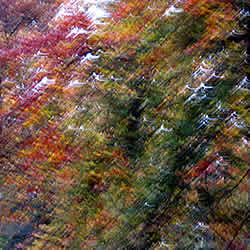 Relatively large, it measures 935 hectares, accommodates 150 distinct kinds
of trees, 200 kinds of birds and no less than 700 different kinds of beetles.
On the other hand, there is an important and usually crammed highway (the
A9) running right through the middle of it. Even better: right over the
Amsterdamse Bos are the main flight paths to Schiphol
airport, which borders on the south-east part of the 'forest'. Schiphol
is among Europe's largest and busiest airports, and it covers an area that
is at least twice that of the Amsterdamse Bos ... So you have this
little island of green, being cut in the middle by a busy highway like a
pie by a chainsaw, enveloped in the continuous distant low-ish drone of
busy life in the dutch capital, and being whipped by the roar of approaching
airliners every one or two minutes during daytime ...
Relatively large, it measures 935 hectares, accommodates 150 distinct kinds
of trees, 200 kinds of birds and no less than 700 different kinds of beetles.
On the other hand, there is an important and usually crammed highway (the
A9) running right through the middle of it. Even better: right over the
Amsterdamse Bos are the main flight paths to Schiphol
airport, which borders on the south-east part of the 'forest'. Schiphol
is among Europe's largest and busiest airports, and it covers an area that
is at least twice that of the Amsterdamse Bos ... So you have this
little island of green, being cut in the middle by a busy highway like a
pie by a chainsaw, enveloped in the continuous distant low-ish drone of
busy life in the dutch capital, and being whipped by the roar of approaching
airliners every one or two minutes during daytime ...
It is an amazing spot ...
As part of the activities around the opening of Yvonne's Mythical Beasts
exposition in the Amsterdamse Bos Visitor's Center, on sunday march 2nd,
I took a group of some 20+ people of all ages for a 'sound walk' into the
park, to find out, hear and listen what it sounds like out there. And -
this was the more specific goal of our little outing - to record
and lay down those sounds. Our 'sound walk' took place in the aftermath
of a pretty heavy storm, which as a matter of fact had managed to rip that
very night the proud large flags waving from two wooden poles in front of
the Center to shreds ...
Therefore there still was quite a bit of wind, which was moreover blowing
from a such direction, that the approaching airliners came soaring in particularly
close and particularly low (the airlines' directions of approach to the
Schiphol runways are modified according to strength and direction of the
wind).
I brought along three cassette dictaphones and one MD player to record with, which I distributed among my fellow walkers. A few had brought their own equipment: Yvonne's neighbor came with his own cassette dictaphone; Harry Buhrman used his cell phone; Wijnand de Groot brought a DAT and a pair of high end mics on a handheld support. I had also brought along four sets of head phones, so that those that were recording could use these to have an immediate impression of their recording - as opposed to the sound that they were hearing with their bare ears. With of course eventually an important lesson to be learned, namely that, however sophisticated your equipment, there is no such thing as a 'true to nature', a fidèle recording. That the sound that you will hear back is always merely an image of the original, no more, but also no less, than that. That it necessarily will be 'colored'. First of all by the equipment, but also - and I'd say even more importantly so - by the presence (or absence !) of the person that is doing the recording. As regular viewers of the soundblog will realize, it actually is precisely this coloration through technology and personal intervention that interests me ...
I assigned somewhat different 'tasks' to different 'recorders'. Thus, for example, I asked one 'group' to specifically try to record in 'close up': around their feet, near the ground, inside bushes and brushwood. And I asked the participant that took my dictaphone with the small lapel microphone, to attach the microphone to her coat and speak at regular intervals little commentaries about and around the sounds and the walk ...
And then we walked.
We walked for somewhat over an hour, in which we did a short tour of the
north western part of the 'forest', starting from and returning to the Visitor's
Center. Ah, and it was a great day for plane spotting, as nearly
every two minutes another airliner came flying over, onto Schiphol. So we
got an awful lot of pretty sound snaps of these.
On the recordings one hears that the sound of a such incoming plane, from fade-in to fade-out,
actually lasts about one whole minute. Now as there is a plane coming in
nearly every two minutes, actually about half of the time the sound
of airplanes can be heard. And all of the time there was that far
away rumbling roar of the city and highway, as a continuous background to the near-by sound of our
chatting and laughing while marching on the gravel or through the brushwood,
alternating with the rumbling of the wind hitting our mikes. And there's
the children's voices, from near and from far. Sometimes, but only some
times we heard the sound of a bird; and then mostly that sound was the crowing of crows ...
There were simply too many of us to hear - let alone record - some of the less common sounds that on earlier occasions I found to be quite characteristic for that small part of the Amsterdamse Bos. Such as the occasional and irregular almost fearful sudden cracking of wood, sounding down from high up near the treetops and lasting no more than a couple of seconds. And the clear high whistling sounds of the wind when blowing through some trees' bare dense branched crown ...
Still, in the end I felt quite happy with the result of the participants' recordings. I found it (again) very interesting to find several recordings of one and the same 'moment', taken from different 'hear-points' and with highly differing 'texture'. Especially interesting was the fifty minute long cell phone recording that Harry Buhrman made during the walk. The AMR (Adaptive Multi-Rate) compression used for cell phone audio recordings comes with a very typically 'colored' filtering of the sound, which becomes - so to say - thin and 'flimsy' as rice paper. It's a really hopelessly lo-fi ... which I like a lot ... The codec also has this curious effect of a swift 'focusing' on speech sounds - but always seemingly arriving 'there' just a bit late ... Somehow somewhere out there something's lurking to do with sound exclusively recorded with cell phones ...
This SB edition's podcast is called
![]() "Nou weer gras!". It is a five minute (edited) selection from Harry's
cell phone recording of our walk through the Amsterdamse Bos on sunday march
2nd, 2008.
"Nou weer gras!". It is a five minute (edited) selection from Harry's
cell phone recording of our walk through the Amsterdamse Bos on sunday march
2nd, 2008.
But that's just an entrée, for as main dish, and 'sound
souvenir' for all that participated in the walk, I made a much longer
piece/reportage, of about 30 minutes, which uses selections from all
the recordings that were collected during the walk (with thanks to all that
held a recording device that afternoon and pushed the red button :-) ...).
The piece/reportage will be edited as a small packaged edition on audio
CDr and also, for those that prefer, on cassette. If you are interested
in acquiring a copy, just drop me a line ...
[ You can visit Yvonne Oerlemans' Mythical Beasts and sit, to daydream and watch them while listening to Wolf, waar ben je?, in the Visitor's Center of the Amsterdamse Bos, Bosbaanweg 5 in Amstelveen (the Netherlands), daily from 12h till 17h, until the first week of may. On sunday april 27th between 14h and 16h, as part of the activities annexe to the exposition, Cécile Zylberajch will interpret Paul Dessau's (1894-1979) Tierverse by Bertolt Brecht, as well as Elf Dierkundige Dichtoefeningen van Trijnte Fop set to music by the dutch composer Johannes Röntgen (1898-1969). ]
notes __ ::
(*) At the time, it was the end of february, that
I was working on Wolf, waar ben je?, I had just more or less finished
a very long (though, in a sense, 'un-changing') track for Emmanuel
Madan's Simulcast 1.0b : Saskatoon. Also in that piece (there is
more about it in the next entry) the number 140 plays an important structural
role. Well, actually I had just 'realized' that the number I should use
was 140, instead of 144 .. :-) .. It was therefore a very curious coincidence
and surprise that when I had the idea to use the 'strandkapper
pizzicato' track from 2005 as a basis for the Mythical Beasts
soundtrack, and counted the number of notes in that track, there turned
out to be precisely 140 of them ... I didn't know there were. At
the time I recorded that (about seven minutes) track in Ameland, I just
hit 'stop' at some point ... [ ^ ]
comments for « Mythical beasts, corsets and kites » ::
|
Comments are disabled |